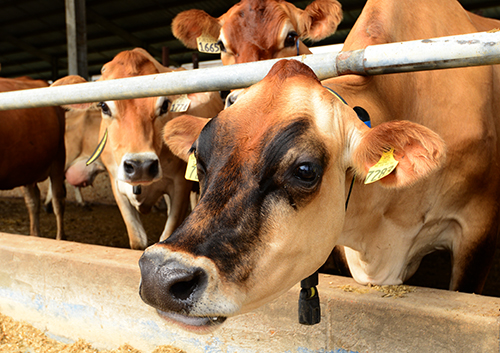Dairy Heifer Growing Program
Jun 12, 2023

Written by: Todd Steen, ProTrition Nutritionist
While feed costs for the lactating cows represent the largest outlay for a dairy operation, producing heifers represents the second largest expenditure. Since the heifer is the future of the herd, managing growth and ultimately age at first calving is significant to the profitability of the operation. Much economic evidence exists suggesting heifers should calve between 22 and 24 months of age. Heifers typically require at least 5% additional costs month-1 when calving later than 24 months. Further, it is well known that earlier calving heifers have increased milk yield compared to later herd mates, as well as improved conception rate and fertility, and they remain in the herd longer. Thus, to realize these great benefits, heifers must perform and reach proper stature and condition.
Researchers recommend two (2) growth benchmarks – heifers should be 55-60% of mature body weight at breeding and 75-85% of mature body weight post-calving (90-95% at calving). While determining mature body weight may seem challenging, evaluate the body weight of 3rd-calf cows to aid in determining the desired growth rate of the heifer program. Below are some guidelines to achieve proper stature and bodyweight for heifers –
If you are looking to improve your dairy heifer development in your herd, the
Co-op is happy to help. Stop by your nearest Co-op location for more information. Find the Co-op nearest you here.
For more content like this, check out the latest issue of The Cooperator.
While feed costs for the lactating cows represent the largest outlay for a dairy operation, producing heifers represents the second largest expenditure. Since the heifer is the future of the herd, managing growth and ultimately age at first calving is significant to the profitability of the operation. Much economic evidence exists suggesting heifers should calve between 22 and 24 months of age. Heifers typically require at least 5% additional costs month-1 when calving later than 24 months. Further, it is well known that earlier calving heifers have increased milk yield compared to later herd mates, as well as improved conception rate and fertility, and they remain in the herd longer. Thus, to realize these great benefits, heifers must perform and reach proper stature and condition.
Researchers recommend two (2) growth benchmarks – heifers should be 55-60% of mature body weight at breeding and 75-85% of mature body weight post-calving (90-95% at calving). While determining mature body weight may seem challenging, evaluate the body weight of 3rd-calf cows to aid in determining the desired growth rate of the heifer program. Below are some guidelines to achieve proper stature and bodyweight for heifers –
- Beginning at birth – it is critical to provide passive immunity to the newborn in the form of high-quality colostrum (both immunoglobulin content & cleanliness). Colostrum should be given ASAP (preferably within 3-31/2 hours after birth). Colostrum should be fed at the rate of 15% of body weight (approximately 4 quarts for Holsteins) along with a second feeding of at least 2 quarts 12 hours after birth. Remember, intestinal absorption of immunoglobulins from colostrum decreases rapidly (<50% absorption 9 hours after birth). If colostrum cannot be administered until 24 hours after birth, the calf will be unable to obtain effective passive immunity resulting in poor performance, probable higher rearing costs, and possibly death.
- Calves are expected to at least double body weight before weaning. To achieve this body weight by six (6) weeks of age, calves should average no less than 2.0 lb. day-1.
- Stature (skeletal & muscle) should represent the majority of weight gain with little fat gain.
- A critical portion of the heifer program is early development of the digestive system to allow for transition from liquid to solid diet.
- Introducing water and specially formulated calf starter by 3-5 days of life will initiate ruminal structure development critical for nutrient abruption.
- Offering forage during milk phase is counter-productive as rumen development is restricted.
- Only high-quality milk replacer should be offered. Pasteurized whole milk (or pasteurized waste milk) is equally effective if milk balancer (supplement) is added.
- For weaning to take place, the calf is required to be consuming at least 2.5-3.0 lbs. of starter day-1 for three (3) consecutive days to maintain desired growth rate after secession of milk feeding.
- From 3–9 months of age, secretory tissue and overall mammary gland development will occur more rapidly than other organs. If excess energy without proper protein is offered, superfluous fat will be deposited, which will disrupt later milk production.
- Evaluate heifers at one (1) yr. of age to determine whether proper size can be achieve for breeding. Typically, 850 lbs. for Holsteins is desired (approximately 650 lbs. for Jerseys).
- Always offer completely balanced rations to maintain desired rate of gain until calving. Remember, the older the animal will deposit more fat than protein making it fundamental to monitor rations.
If you are looking to improve your dairy heifer development in your herd, the
Co-op is happy to help. Stop by your nearest Co-op location for more information. Find the Co-op nearest you here.
For more content like this, check out the latest issue of The Cooperator.